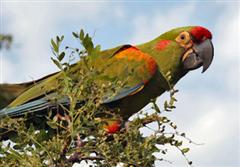Macaw - Lafresnaye's
Lafresnayes Macaw Scientific Name: Ara severa castaneifrons
Sat, 19th July, 2025 - 3:29 am GMT
Sponsor Ads:

Alternative Name
Lafresnayes Macaw Scientific Name: Ara severa castaneifronsBasic Info
The Lafresnaye Macaw is about nineteen inches in length and is crowned with a line of chestnut colored feathers across the forehead. The plumage is primarily metallic green, and the crown is blue. The shoulders are red. Lafresnaye Macaws have blue flight and tail feathers with red undersides. Their bare facial patch exhibits delicate feather lines, the chin is a dark reddish brown, and the underside of the tail is a dark chestnut color. The bill is black and the legs are dark gray with red "socks". Lafresnaye Macaws have brownish-red irises. The wingspan of Lafresnaye Macaws is nine to ten inches. When setting up pairs, Lafresnaye Macaws must be sexed using DNA or surgical methods. Immature Lafresnaye Macaws will have blacker colored bands on the foreheads, as the chestnut color develops with maturity, and you may use this indicator to determine the bird's breeding capabilities.
Health
Lafresnaye Macaws do well when fed on a variety of foods including; fruits, vegetables, and commercial pellets. White bread and biscuits are the perfect food to hand rear young Lafresnaye Macaws. Pasta, beans, pine nuts, and porridge all make fine treats for Lafresnaye Macaws. They also need fresh water at all times, and love bathing! Because of their smaller size, Lafresnaye Macaws will do well in an outdoor nine by three by six food enclosure with an enclosed shelter. Lafresnaye Macaws do best if kept in pairs within hearing distance of each other. They are quite noisy and need lots of attention to prevent loneliness and depression. They are sturdy after acclimatization but should not be kept below 41 degrees Fahrenheit. Breeding In captivity, Lafresnaye Macaws are quite prolific if paired correctly. The breeding season usually begins in May, when Lafresnaye Macaws may become aggressive, attacking similar sized birds or their handler. Give your birds a diagonally oriented nesting box with a twelve-inch entry hole and 10 by 14 by 16-inch dimensions. These Macaws usually have clutches consisting of about four eggs that hatch in 26 days. Generally, not all the eggs will be fertile. The fledgling period lasts about twelve weeks and young Lafresnaye Macaws are quite independent two weeks after leaving their parents.Habitat
N/ABehavior
With a colorful personality, the Lafresnaye Macaw is all the fun of a large Macaw rolled into a smaller package! A rare subspecies of the Severe Macaw, it is just as friendly and playful and slightly larger! Lafresnaye Macaws are found in tropical forests up to 5000 feet in altitude and stray occasionally into villages or cultivated areas. They love treetops and often associate with other Macaws, making lots of noise while they forage for . They breed between January and April in northern ranges and November to January in southern ranges, nesting in very high dead trees or branches. Living in small groups of three to 15 in the wild, the Lafresnaye Macaw is extremely social and loves to mimic speech and be petted and played with! Best if kept in pairs, these Macaws are quite intelligent and should be provided with ropes to swing on and lots of wood to chew, for they can get quite destructive if bored. Forming strong bonds with their keepers, they are affectionate, silly, and active, and love to climb, explore, and hang upside down, chatting and squawking often. Lafresnaye Macaws relate to their world by chewing on it, and this may include you! They should be taught early on to regulate the pressure of their beaks.Because of their smaller size, Lafresnaye Macaws will do well in an outdoor nine by three by six food enclosure with an enclosed shelter, however, be sure it is sturdy and do not give these birds toys intended for small birds! They also need fresh water at all times, and love bathing!Origin
South AmericaHistory
Lafresnaye Macaws are native to northern Venezuela up through the Guyanas and south to northeast Brazil. They range through coastal Columbia, eastern Panama and Peru, and northern Bolivia. They are little known as companion animals though they make wonderful family pets when captive bred and hand raised and remain quite rare.Common Foods
They do well when fed on a variety of nuts, grains, seeds, fruits, vegetables, mineral supplements, green food, and commercial pellets. White bread and biscuits are the perfect food to hand rear young Lafresnaye Macaws. Pasta, beans, pine nuts, and porriSponsor Ads:
At the source of every error which is blamed on the computer you will find at least two human errors, including the error of blaming it on the computer.
Macaw - Lafresnaye's
Coded by: BGID® | ALL RIGHTS RESERVED Copyright © 2000-2025
Disclaimer | Privacy | Report Errors / Contact | Credits








 President of the United States of America - Real Estate mogul, Pageant owner and now one of the most controversial men in political history.
President of the United States of America - Real Estate mogul, Pageant owner and now one of the most controversial men in political history.  Global warming has been in and out as the "latest" hot topic for many years. It is, according to modern scientists, the result of man-made industrial pollutants, clearing forested areas, agriculture, etc. But now they are thinking it started way before the Industrial Revolution...
Global warming has been in and out as the "latest" hot topic for many years. It is, according to modern scientists, the result of man-made industrial pollutants, clearing forested areas, agriculture, etc. But now they are thinking it started way before the Industrial Revolution...  Politician, US Vice President and President of the USA - Joseph Robinette Biden Jr.
Politician, US Vice President and President of the USA - Joseph Robinette Biden Jr.  versus
versus  Russia: 'The Evil Empire'? Are they all that bad or is it just the USA trying to portray Russia as bad because they are a world power with land bigger and a society very different from the USA ideal?
Russia: 'The Evil Empire'? Are they all that bad or is it just the USA trying to portray Russia as bad because they are a world power with land bigger and a society very different from the USA ideal? 
 Corona virus
Corona virus 
 Users with wide screen monitors can benefit from more content on every page.
Users with wide screen monitors can benefit from more content on every page.